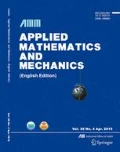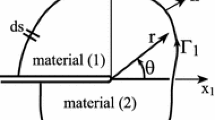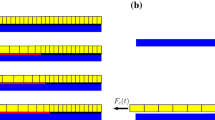Abstract
A new approach, called “β=0 approach” is presented for use in the prediction of interfacial crack growth. This approach is a kind of transformation. It transforms an oscillatory stress field to a nonoscillatory case by adjusting the elastic constants of the materials involved. The interface toughness locus is also changed according to the new material properties. It is shown that this approach will predict the exact same critical load as interfacial fracture mechanics does. Finally, several examples are presented to show how to enforce β=0 while keeping the energy release rate unchanged.
Similar content being viewed by others
References
Z. Suo, Singularities, interfaces and cracks in dissimilar anisotropic media,Proc. R. Soc. Lond., A427 (1990), 331–358.
M.-Y. He and J. W. Hutchinson, Kinking of crack out of an interface,J. Appl. Mech.,56 (1989), 270–278.
J. W. Hutchinson, Mixed mode fracture mechanics of interface,Metal-Ceramic Interfaces, ed. by M. Ruhle, A. G. Evans, M. F. Ashby and J. P. Hirth Pergamon Press, New York (1990).
J. Dundurs in Mathematical Theory of Dislocations, ASME (1969), 70–115.
J. R. Rice, Elastic fracture mechanics concepts for interfacial cracks,J. Appl. Mech.,55, (1988), 98–103.
R. A. Schapery and B. D. Davidson, Prediction of energy release rate for mixed-mode delamination using classical plate theory,Appl. Mech. Review,43 (Part 2) (1990), S281-S287.
B. D. Davidson, H. Hu. and R. A. Schapery, An analytical crack tip element for layered elastic structures,J. Appl. Mech.
E. F. Rybicki and M. F. Kanninen, A finite element calculation of strss intensity factors by a modified crack closure integral,Eng. Fract. Mech.,9, (1977), 931–938.
Z. Suo and J. W. Hutchinson, Interface crack between two elastic layersInt. J. Fracture.43 (1990), 1–18.
Author information
Authors and Affiliations
Rights and permissions
About this article
Cite this article
Hurang, H., Chengping, W. A new approach to predicting interfacial crack growth. Appl Math Mech 18, 37–44 (1997). https://doi.org/10.1007/BF02457499
Received:
Issue Date:
DOI: https://doi.org/10.1007/BF02457499




